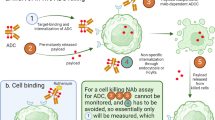Abstract
For biosimilar drug development, it is critical to demonstrate similar physiochemical characteristics, efficacy, and safety of the biosimilar product compared to the reference product. Therefore, pharmacokinetic (PK) and immunogenicity (antidrug antibody, ADA) assays that allow for the demonstration of biosimilarity are critical. Under the auspices of the American Association of Pharmaceutical Scientists (AAPS) Ligand-Binding Assay Bioanalytical Focus Group (LBABFG), a Biosimilars Action Program Committee (APC) was formed in 2011. The goals of this Biosimilars APC were to provide a forum for in-depth discussions on issues surrounding the development and validation of PK and immunogenicity assays in support of biosimilar drug development and to make recommendations thereof. The Biosimilars APC’s recommendations for the development and validation of ligand-binding assays (LBAs) to support the PK assessments for biosimilar drug development are presented here. Analytical recommendations for the development and validation of LBAs to support immunogenicity assessments will be the subject of a separate white paper.




Similar content being viewed by others
References
Biological approvals by year. Vaccines, Blood & Biologics. U.S. Department of Health and Human Services. Food and Drug Administration. Silver Spring, MD. 2014. http://www.fda.gov/BiologicsBloodVaccines/DevelopmentApprovalProcess/BiologicalApprovalsbyYear/ucm385842.htm . Accessed 24 June 2014.
U.S. Department of Health and Human Services. Food and Drug Administration. Docket No. FDA-2010-N-0477. Approval pathway for biosimilar and interchangeable biological Products. Public Hearing November 2010.
European Medicines Agency. CHMP/437/04. Guideline on similar biological medicinal products. October 2005.
European Medicines Agency. EMEA/CHMP/BMWP/42832/2005. Guideline on similar biological medicinal products containing biotechnology-derived proteins as active substance: Non-clinical and clinical issues. June 2006.
European Medicines Agency. EMEA/CHMP/BWP/49348/2005. Guideline on similar biological medicinal products containing biotechnology-derived proteins as active substance: Quality issues. June 2006.
U.S. Department of Health and Human Services. Food and Drug Administration. Center for Drug Evaluation and Research (CDER). Center for Biologics Evaluation and Research (CBER). Biosimilars: Questions and answers regarding implementation of the biologics price competition and innovation Act of 2009. February 2012 (Draft).
U.S. Department of Health and Human Services. Food and Drug Administration. Center for Drug Evaluation and Research (CDER). Center for Biologics Evaluation and Research (CBER). Quality considerations in demonstrating biosimilarity to a reference protein product. February 2012 (Draft).
U.S. Department of Health and Human Services. Food and Drug Administration. Center for Drug Evaluation and Research (CDER). Center for Biologics Evaluation and Research (CBER). Scientific considerations in demonstrating biosimilarity to a reference product. February 2012 (Draft).
DeSilva B, Smith W, Weiner R, Kelley M, Smolec JM, Lee B, et al. Recommendations for the bioanalytical method validation of ligand-binding assays to support pharmacokinetic assessments of macromolecules. Pharm Res. 2003;20:1885–900.
U.S. Department of Health and Human Services. Food and Drug Administration. Center for Drug Evaluation and Research (CDER). Center for Veterinary Medicine (CVM). Guidance for industry: Bioanalytical method validation. May 2001.
European Medicines Agency. EMEA/CHMP/EWP/192217/2009. Guideline on bioanalytical method validation. February 2012.
Smolec J, DeSilva B, Smith W, Weiner R, Kelley M, Lee B, et al. Bioanalytical method validation for macromolecules in support of pharmacokinetic studies. Pharm Res. 2005;22:1425–31.
Viswanathan CT, Bansal S, Booth B, DeStefano AJ, Rose MJ, Sailstad J, et al. Workshop/conference report—quantitative bioanalytical methods validation and implementation: Best practices for chromatographic and ligand binding assays. AAPS J. 2007;9:E30–42.
Fast DM, Kelley M, Viswanathan CT, O’Shaughnessy J, King SP, Chaudhary A, et al. Workshop report and follow-up—AAPS workshop on current topics in GLP bioanalysis: Assay reproducibility for incurred samples—implications of Crystal City recommendations. AAPS J. 2009;11:238–41.
Cai X-Y, Gouty D, Baughman S, Ramakrishnan MS, Cullen C. Recommendations and requirements for the design of bioanalytical testing used in comparability studies for biosimilar drug development. Bioanalysis. 2011;3:535–40.
Findlay JW, Smith WC, Lee JW, Nordblom GD, Das I, DeSilva BS, et al. Validation of immunoassays for bioanalysis: A pharmaceutical industry perspective. J Pharm Biomed Anal. 2000;21:1249–73.
Findlay JW, Dillard RF. Appropriate calibration curve fitting in ligand binding assays. AAPS J. 2007;9:E260–7.
European Medicines Agency. CHMP/437/ 04 Rev 1. Guideline on similar biological medicinal products. May 2013 (Draft).
Munson, P. ALLFIT Registration. 2007. http://abs.cit.nih.gov/allfit/register.html . Accessed 24 June 2014.
Schuirmann DJ. A comparison of the two one-sided tests procedure and the power approach for assessing the equivalence of average bioavailability. J Pharmacokinet Biopharm. 1987;15:657–80.
Author information
Authors and Affiliations
Corresponding author
Additional information
This article represents the scientific opinion of many experts and, in particular, is derived from a series of workshops held under the auspices of the AAPS Ligand-Binding Assay Bioanalytical Focus Group Biosimilars Action Program Committee. It is now presented as an AAPS white paper to support activities, programs, and decisions in the scientific, technical, and regulatory community. Even though it is a final white paper, the authors expect further progress to be made rapidly in this evolving field when this paper is published. Thus, comments and additional contributions are welcome and may be considered for a revision of the position paper in due course.
Electronic supplementary material
Below is the link to the electronic supplementary material.
Supplemental 1
(XLSX 72 kb)
Supplemental 2
(XLSX 59 kb)
Supplemental 3
(DOCX 15 kb)
Rights and permissions
About this article
Cite this article
Marini, J.C., Anderson, M., Cai, XY. et al. Systematic Verification of Bioanalytical Similarity Between a Biosimilar and a Reference Biotherapeutic: Committee Recommendations for the Development and Validation of a Single Ligand-Binding Assay to Support Pharmacokinetic Assessments. AAPS J 16, 1149–1158 (2014). https://doi.org/10.1208/s12248-014-9669-5
Received:
Accepted:
Published:
Issue Date:
DOI: https://doi.org/10.1208/s12248-014-9669-5




